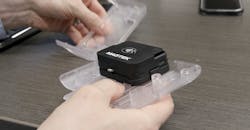Vaulting the Preproduction Processing
New product development can be a tricky business, and often takes far longer than most anticipate. Multiple steps and iterations are commonplace. This is especially true within the electronics industry where the next model is always highly anticipated.
As a leading manufacturer of enclosures for tablets, Vault is quite familiar with the process. With over 20 years of experience creating point of sale solutions, Vault has fine-tuned the process of offering highly configurable and customizable solutions using an agile design-to-production workflow to answer the growing need for quality-made, uniquely branded POS stands and enclosures.
A key technology within Vault’s process is 3D Systems’ stereolithography (SLA), which it uses throughout pre-production for everything from proof of concept, to final concept, to mold and tooling set up, to packaging. One major reason for this is speed.
Ready for the show
Vault put the SLA system to a test in December when approached by a multibillion-dollar customer with a big request and small timeline. Vault needed to design, approve, mold and produce a final, custom product within two months. The reason for the tight timeline? The customer needed a fresh concept finalized and delivered in time for a trade show in early February.
“They were blown away by the surface finish, the quality, and the overall level of work that we were able to show them based on a conversation we had had just 2 weeks earlier,” says Quentin Forbes, VP Engineering at VAULT. “And we didn’t do any post-op finishing on the prints either. They won over our client straight from the printer.”
Speed wasn’t the only benefit. The transparency of Accura ClearVue facilitated crystal clear communications, between departments at Vault as well as with the end-customer. Additionally, the surface finish and accuracy of 3D Systems’ SLA prints enable them to inform tooling, increasing confidence in investment and accelerating timelines.
Forbes says Vault has found the clear resin, to be a major help in optimizing design. Printing new components in clear helps deliver a full understanding of various mechanisms and space-claims to problem-solve for better outcomes.
“Customers don’t always understand how things will ultimately integrate and fit, so there’s a real utility and cool factor to being able to print in clear,” says Forbes. “When you can see through a part, there’s really no discussion, there’s just solutions and resolved questions.”
For final production, Vault relied on two-ton molds for plastic injection molding as well as aluminum die casting. The 3D printed prototypes provided the mold manufacturers with a reference that assisted them in creating the molds faster, as well as accelerating the post-operation set ups, including a foil stamp. The extreme thinness of the foil stamp and the accuracy required to place it correctly usually forces this step to be delayed until a production part can be used to assist with placement. In this case, the high accuracy of the SLA prototype made it possible to prepare this step ahead of time and not lose momentum.
“The speed and resolution we can achieve with the ProJet 7000 made it possible to get customer approval quickly, start development quickly, and reduce mold manufacturing time,” says Forbes. “We were also able to use the prototype as the basis of all our packaging design, and when the production parts were ready, they fit perfectly.”
According to Forbes, Vault went straight from training on sample prints to a big project without hesitation. “We went from 0 to 100 miles per hour with the ProJet right away,” he says. “It’s a testament to how well 3D Systems does training, and how reliable your printers are in building. We came out of our training session and printer installation and didn’t lose any time getting into very large and long prints, without any issues.”


